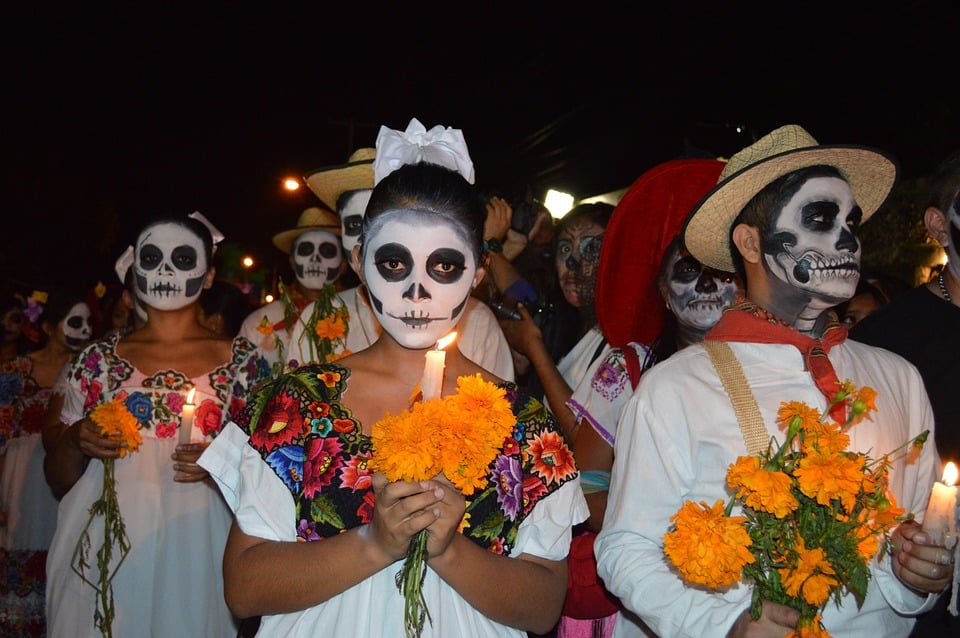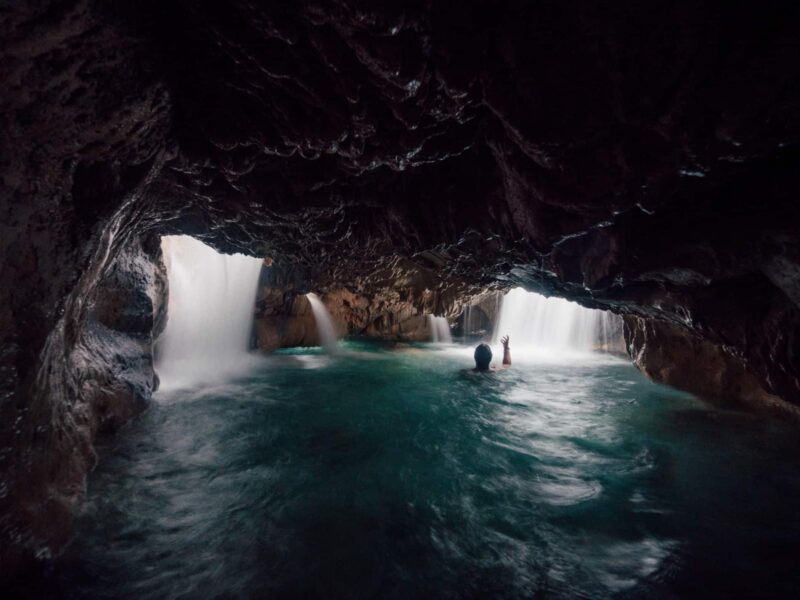“To live in hearts we leave behind is not to die.” — Thomas Campbell, “Hallowed Ground”
Contrary to its grim name, Day of the Dead (El Día De Los Muertos) is actually a beautiful and cheerful holiday. Bright yellow and orange marigold flowers, sweet breads, painted faces, parades and family time all make this holiday a special time of reflection and celebration not only of the dead, but with the dead. The celebrations for Day of the Dead are as diverse as sugar-skull designs decorating faces on this misunderstood holiday.
Read on to learn how cemetery parties can be upbeat and prepare for your brush with death when you visit Mexico for Day of the Dead!
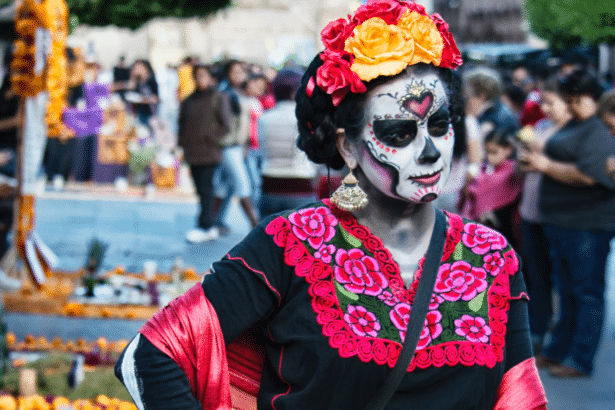
What is Day of the Dead?
Day of the Dead is a celebration of life and welcoming back of the dead every October 31 through November 2. Traditionally in Mexico, death is not feared or seen as the end, but rather as a part of the life cycle. The belief is that the dead “awaken” during these days and are guided by candles and the scents of cempazúchitl and copal to their loved ones for enjoyment of offerings and quality time with the living. While every town has different ways of celebrating, and even every family, common themes and traditions like ofrendas, depictions of skeletons and faces painted as catrinas fill most places.
Day of the Dead is a popular celebration—movies like Spectre, Coco and The Book of Life feature this special holiday, as well as UNESCO adding it to the list of Intangible Cultural Heritage of Humanity. Celebrations typically begin on the night of October 31 when heaven’s gates open and spirits of deceased children return to their families for the duration of November 1, known as Day of the Innocents or Day of the Little Angels (Día de los Inocentes, Día de los Angelitos). The following day, known as Day of the Dead (Día de los Difuntos, Día de los Muertos), deceased adults return to the land of the living. You may see depictions of dogs as they are believed to guide the spirits back to the Land of the Dead after their brief visit.
History of Day of the Dead in Mexico
Day of the Dead goes way back—approximately 3,000 years! Scholars believe it started with the Aztec’s month-long summer festival worshipping Mictēcacihuātl, goddess of the underworld. Ancient civilizations did not fear death and thought that sorrow was disrespectful to the dead, they instead saw death as part of the life cycle.
When the Spanish arrived in the 16th century, they viewed Day of the Dead (or Xantolo in the Aztec’s Nahuatl language) rituals as sacrilegious. Ancient traditions don’t just disappear overnight and over a few hundred years, many pre-Columbian rituals and traditions mingled with Catholic ones, which is exactly what happened with Day of the Dead. The holiday was moved from the summer to coincide with the minor Catholic holidays All Saints’ Day and All Souls’ Day on November 1 and 2.
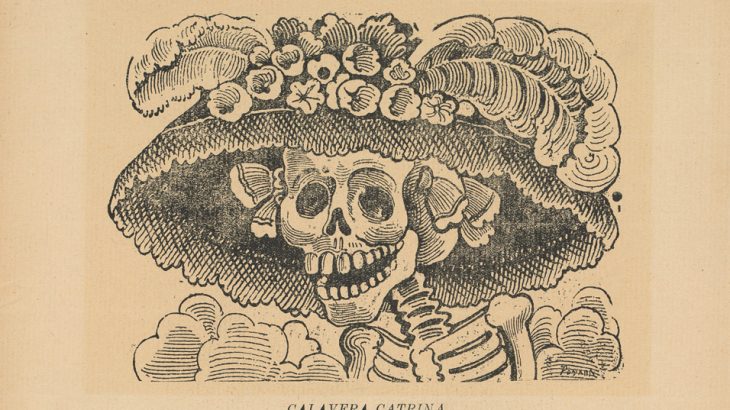
History of La Calavera Catrina & Today’s Sugar Skulls
Ah, where do we begin with La Calavera Catrina, Mexico’s elegantly-dressed depiction of death.
It all started in 1910 with José Guadalupe Posada, known as Mexico’s Father of Printmaking. Posada grew up during Porfiriato, the presidency of Porfirio Díaz in Mexico. He first featured this elegant lady of death in the leaflet “La Calavera Garbancera“, highlighting the corruption and stark contrast between the very wealthy and starving poor under Porfirio, while also showing (especially by the fancy hat) that death doesn’t discriminate based on class. She was supposed to symbolize someone lavishly dressed, emulating European style with a fancy feathered hat and donning white makeup to hide Indian roots. La Calavera Catrina was understandable to Mexican’s of every socioeconomic status and came just as the Mexican Revolution—that would eventually topple Porfirio—was gaining speed.
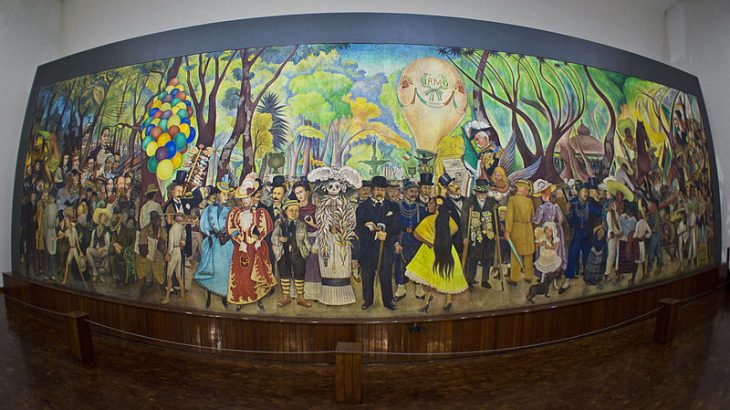
But that’s not the end of La Catrina’s legacy. In 1947 Diego Rivera brought La Catrina back to life—and with a full form! Husband to Frida Kahlo, Rivera looked up to Posada and had interactions with him in his shop as a young child. La Catrina Calavera made her grand appearance in Rivera’s painting Dream of a Sunday Afternoon in Alameda Park, that showcased more than 400 years of Mexican history. Sporting a French-style feather hat and plumed-serpent boa over her white dress with a chain holding eyeglasses dangling effortlessly below her waist, Mexico’s Grand Dame of Death forever imprinted herself in history as La Calavera Catrina, a symbol of Mexico’s relationship with death—different from Calavera Garbancera, a social and political commentary.
In present times, “sugar skull” is used in reference to actual sugar skulls on altars with the deceased’s name across the forehead, tattoos, halloween makeup and of course, Day of the Dead.
Differences Between Halloween & Day of the Dead
Halloween and Day of the Dead may share the same day of the year, but they couldn’t be more different. Halloween tends to be dark and scary, with spirits seen as evil or malevolent, Day of the Dead is bright, cheerful and celebratory; spirits are seen as jovial and families welcome their return.
It’s hard to imagine gathering in a cemetery for the evening as merry, but that’s exactly how it is in Mexico. It’s a time Mexican families visit with friends and family and see everyone from town while sharing food and drinks and reminiscing about when the deceased were alive. When in Mexico for Day of the Dead, you’ll notice even the depictions of skeletons are celebrating—dressed up, getting married, dancing, drinking and playing instruments. Pretty different from trick-or-treating on Halloween, huh?
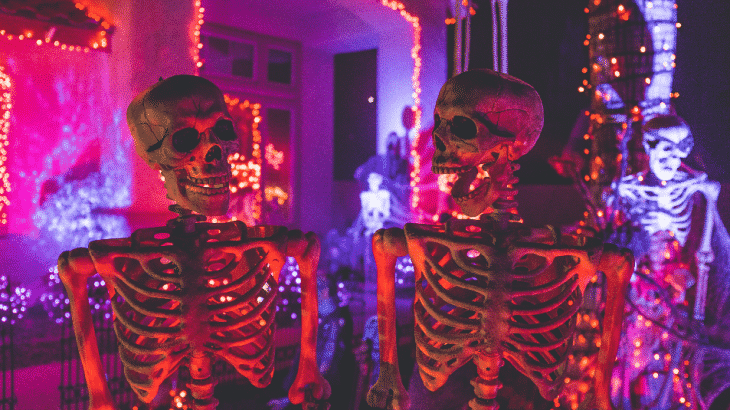
History of Halloween
Halloween comes from the early Celts pagan festival of Samhain where celebrated the Celtic New Year on November 1, the end of harvest season. They believed that on this special night of the year, the border between the realms of life and death diminished and the spirits could explore the land of the living. When the Catholics came along, they once again, tried to squash tradition, meshing Samhain with All Saints’ Day and All Souls’ Day. This new festival was commonly known as All Hallows with the night before known as All Hallows Eve which eventually became “Halloween”.
Many of the Halloween traditions in the United States and around the world today come from the original Samhain festival, including costumes, trick-or-treating and bobbing for apples. While there a numerous stories of where these traditions actually came from, it’s believed costumes were worn to hide from spirits walking the earth and even disguise yourself as a spirit so they wouldn’t harm or bother you; bobbing for apples has lore including everything from it was used in matchmaking to as a gruesome ritual of bobbing for apples in scalding liquid to avoid being sacrificed; and trick-or-treating came from the practice of “souling” when children or the impoverished would go from door to door on All Hallow’s Eve dressed up in costumes begging for food or money, frequently on behalf of the dead.
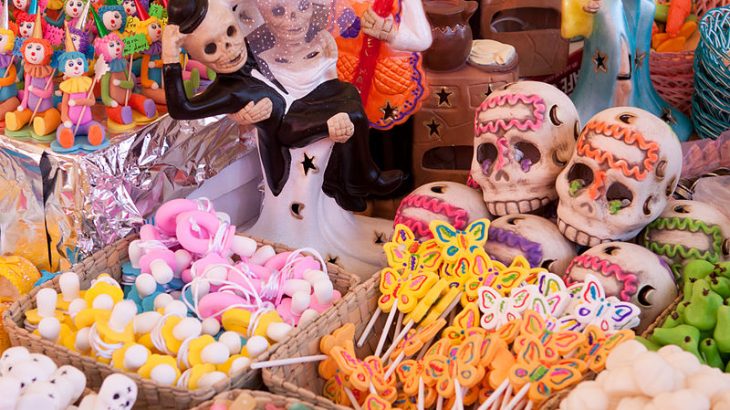
Popular Day of the Dead Traditions
There are two sides to Day of the Dead, the public side largely influenced by pop culture and modern times and the more traditional side. In places like Mexico City you’ll see large parades, live music, parties and catrina costume contests, but if you want to experience the more intimate and authentic side of the Day of the Dead, head to a cemetery.
For many families, Day of the Dead celebrations are still very sacred—some families spend up to two months’ salary on supplies for their altars and decorations. They believe the dead have a long journey and they dare not disappoint them with a less-than-impressive altar on their arrival. While Day of the Dead differs widely based on where you’re from and even your family, the following practices are what you’ll commonly see in Mexico.
Creation of Altars With Personalized Offerings
Known as altares, altars are constructed for passed away loved ones. The altar is decorated and covered in ofrendas (offerings) including cempazúchitl; incense; sugar skulls bearing the deceased’s name; pan de muerto; images of saints; the deceased’s favorite food, drinks and possessions; alcohol; salt; papel picado and a photo of the deceased.
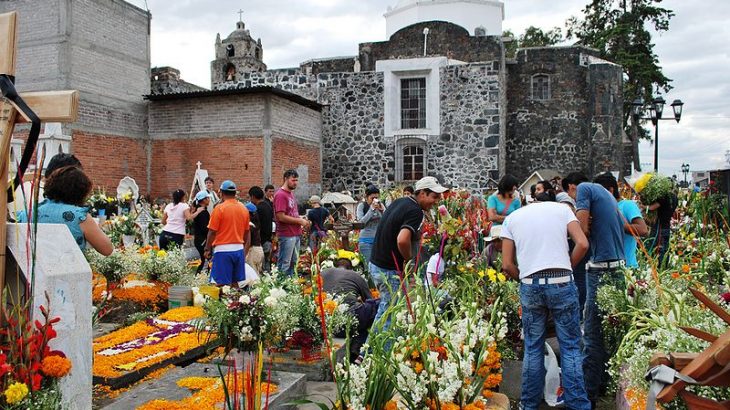
Cleaning of Graves & Night-long Vigils
On Day of the Dead in Mexico and the days leading up to it, families head to cemeteries to clean the graves and add decorations and offerings like marigolds, candles, photos and the deceased’s favorites things from life. In many areas, families spend the night at the grave, enjoying food and drinks and reminiscing about when dead were alive. Depending on how urban the area, sometimes full on parties are held in cemeteries, with bands going from grave to grave, heavy drinking and socializing with others celebrating their dead.
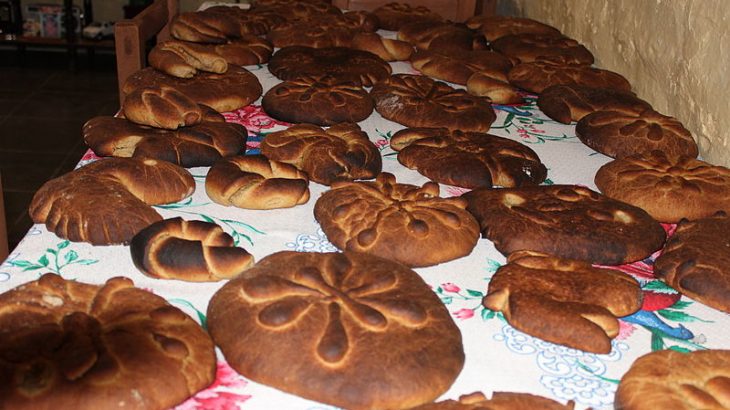
Eating Pan de Muerto & Other Foods
Eating the “bread of the dead” on Day of the Dead and the days leading up to it is customary across Mexico. Pan de muerto is a sweet bread baked with anise seeds, a hint of orange flavor and bone designs over top. It comes in all shapes and sizes depending on what part of Mexico you’re in, and it’s an essential piece on altars for the dead. You may see it with sprinkles or sesame seeds on top and sometimes with sweet fillings inside.
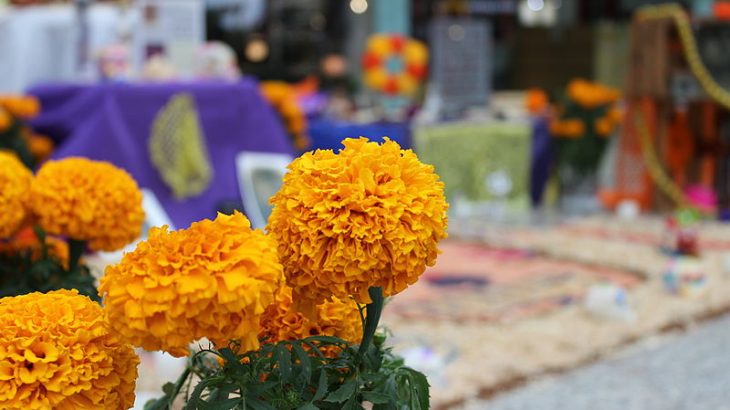
Decorations With Cempazúchitl
In October and November, you’ll notice the streets and homes in Mexico are blanketed in bright yellow and orange Marigold flowers or Cempazúchitl flowers. Known as the flower of the dead (flor de muerto) marigolds’ strong aroma is believed to help the dead find the way to their families—hence their use in altars and pathways from the grave to the altar. Native to Mexico, marigolds bloom just in time for Day of the Dead celebrations.
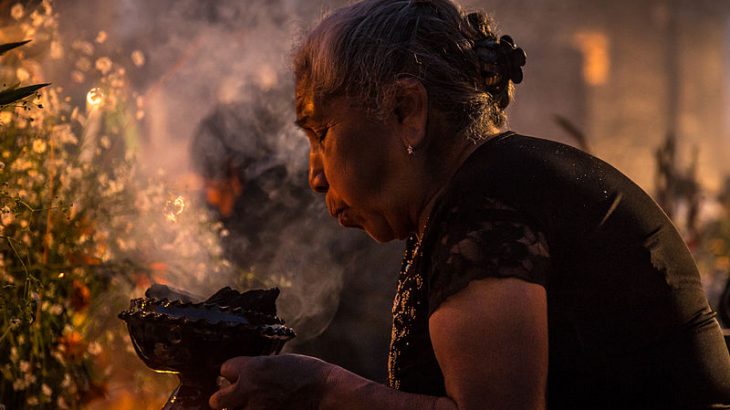
Burning Copal
Similar to Cempazúchitl, the scent of copal is believed to attract spirits and guide them home, making it an integral piece on an altar. Copal or the “Mexican Frankincense” comes from the Copalli Tree and burning its resin dates back to Mesoamerican times with the Aztecs and Incas.
Calaveras Literarias
Writing calaveras literarias or “literary skulls” is a Day of the Dead tradition popularized in the 19th century by people like José Guadalupe Posada. Generally between two to four lines, these satirical poems poke fun at living politicians, famous people, friends and family as if they’re dead or about to meet death—awfully useful when expressing your disapproval for your political representatives. Calaveras literarias are also written about the deceased or death itself, generally in a mocking or funny tone.
Sharing Stories & Memories of Loved Ones
Day of the Dead is a happy time—a time of remembering those who has passed on and celebrating their lives. Families and friends bring out old photos, share stories and joke about both the dead and living.
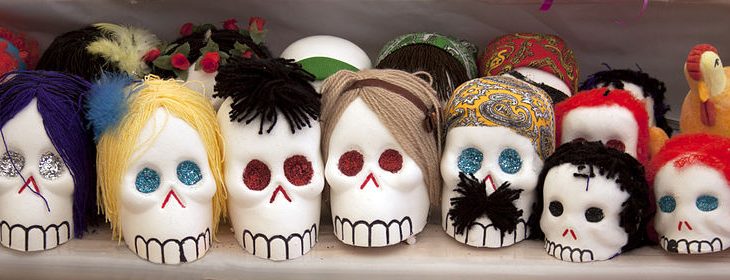
Purchase & Display of Sugar Skulls
If you’re familiar with any Day of the Dead tradition, it’s likely that of the sugar skull. Sugar skulls are placed on altars and graves to represent the one who has passed, small skulls for children who passed (angelitos) and larger skulls for adults. Normally the deceased’s name is written across the forehead and the rest of the skull is decorated with brightly-colored frosting, ribbons and sparkles. In addition to the physical object, sugar skulls infiltrate every facet of Day of the Dead. The papel picado is decorated with sugar skulls, there are contests for the best sugar skull face paint and the list goes on and on.
Many Day of the Dead traditions have spilled into Halloween and pop culture, but none as strongly as the sugar skull. People paint their faces as sugar skulls for Halloween, decorate their homes with them and even get sugar skull tattoos.
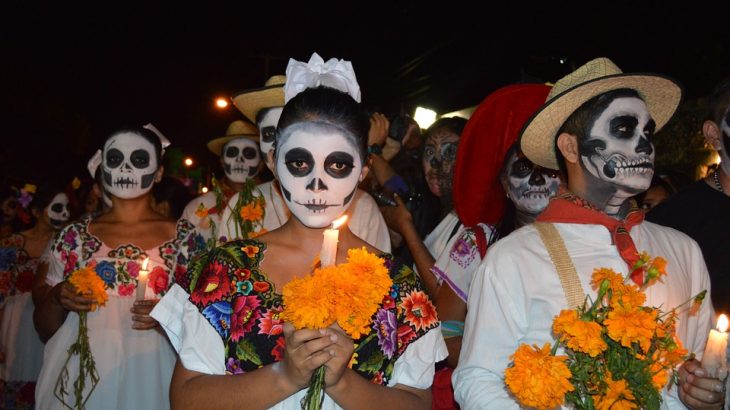
Dressing Up as La Calavera Catrina & El Catrin
One of the most exciting parts of Day of the Dead is dressing up for the parades, catrina contest or simply to celebrate the holiday or a specific loved one. Most women paint their faces as La Catrina and wear a long dress with heavy emphasis on flowers and color in their ensemble, while men go the dapper route—black and white makeup of a skull on their face and suites or tuxedos with a hat. Our How to Dress for Day of the Dead article has more tips for you as you prepare ya drop dead gorgeous look!
Once the otherworldly celebrations are over, spend your pesos exploring Mexico’s glassy water, tropical beaches and ancient ruins…after all, you can’t take them with you!
